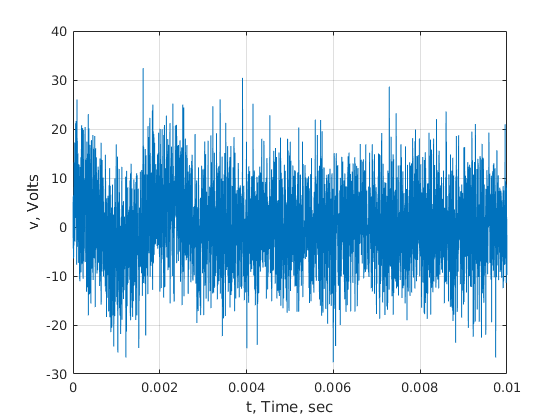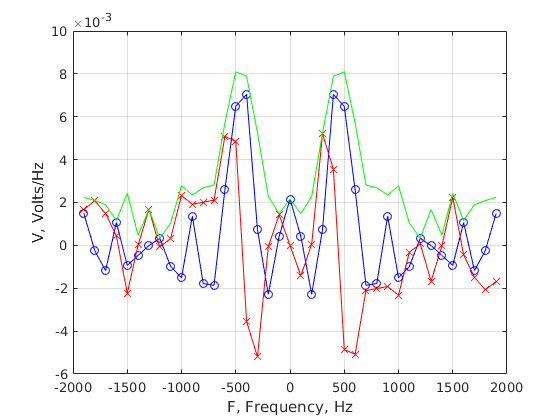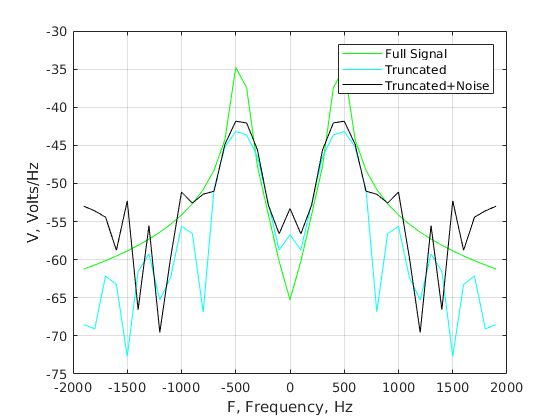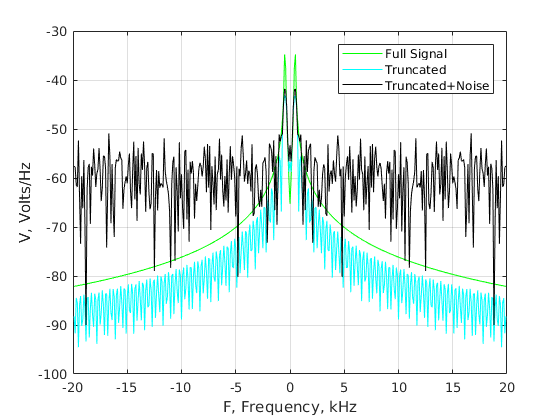Contents
% /home/dimarzio/Documents/working/12229/lectures/ftransform.m % Sat Nov 4 14:39:30 2017 % Chuck DiMarzio, Northeastern University %
Fourier transform
t=[1:4096]*10e-3/4096; % Time axis T=1024*10e-3/4096; % Period of a periodic function f0=1/T omega0=2*pi*f0; % Sampling Frequency dt=t(2)-t(1) fsample=1/dt
f0 =
400
dt =
2.4414e-06
fsample =
409600
Start with a sinusoidal wave
vm=5;phi=30*pi/180;v=vm*cos(omega0*t+phi); figure;plot(t,v);grid on; xlabel('t, Time, sec');ylabel('v, Volts'); % Fourier transform V=fft(v); figure;plot(1:length(t),real(V),1:length(t),imag(V));grid on; xlabel('?');ylabel('?'); % Plot the first and last 10 points figure;plot(1:10,real(V(1:10)),'bo-',... 1:10,imag(V(1:10)),'r-x');grid on; xlabel('?');ylabel('?'); figure;plot(4087:4096,real(V(4087:4096)),'b-o',... 4087:4096,imag(V(4087:4096)),'r-x'); grid on; xlabel('?');ylabel('?');
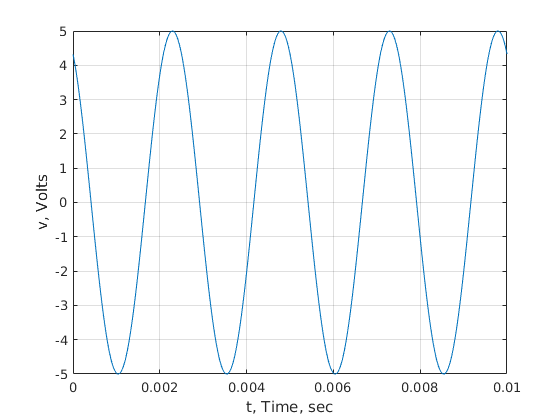
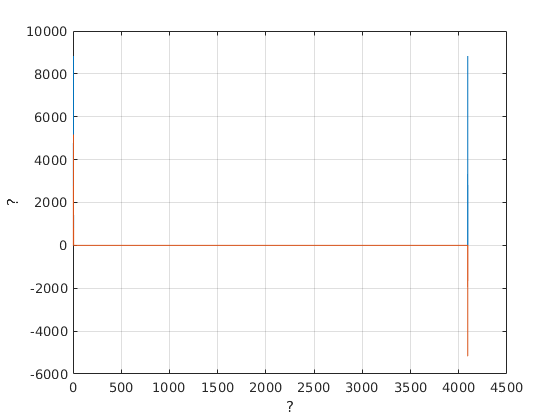
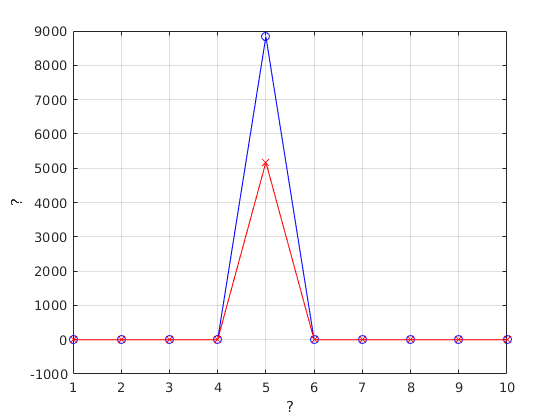
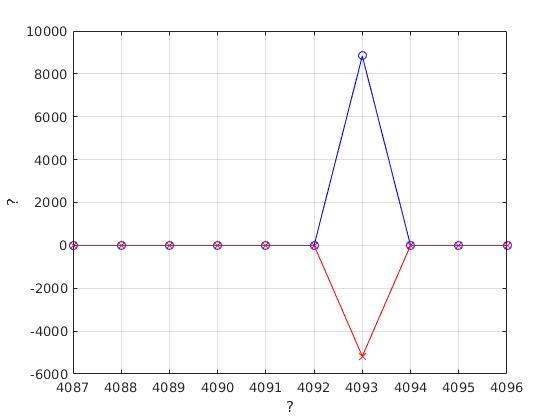
Use a frequency axis and scale the voltage
V=V/4096*max(t); f=fftaxis(t); % needs fftaxis.m by Chuck DiMarzio % Plot the first and last 10 points figure;plot(f(1:10),real(V(1:10)),'bo-',... f(1:10),imag(V(1:10)),'r-x');grid on; xlabel('f, Frequency, Hz');ylabel('V, Volts/Hz'); figure;plot(f(4087:4096)/1000,real(V(4087:4096)),'b-o',... f(4087:4096)/1000,imag(V(4087:4096)),'r-x'); grid on; xlabel('F, Frequency, kHz');ylabel('V, Volts/Hz');
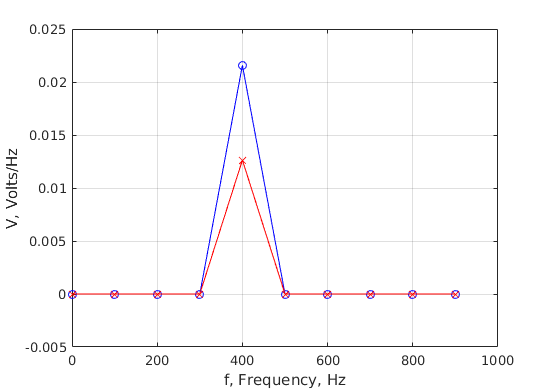
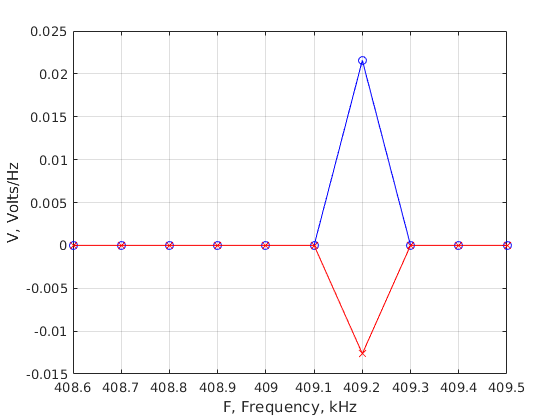
Deal with the periodicity of the FFT
f=fftaxisshift(f); % needs fftaxisshift.m by Chuck DiMarzio V=fftshift(V); % Existing function in matlab figure;plot(f,real(V),f,imag(V));grid on; xlabel('F, Frequency, kHz');ylabel('V, Volts/Hz'); %Plot the interesting region test=find(abs(f)<2*f0); figure;plot(f(test),real(V(test)),'b-o',... f(test),imag(V(test)),'r-x');grid on; xlabel('F, Frequency, kHz');ylabel('V, Volts/Hz'); % What is the amplitude? % There are only 2 points, so inverse FT is quite easy. Multiply % by df and exp(1j*2*pi*f*t) where f = +/- f0. Vmax=max(abs(V))
Vmax =
0.0250
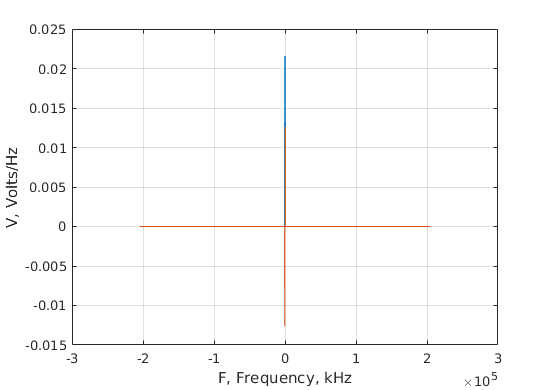
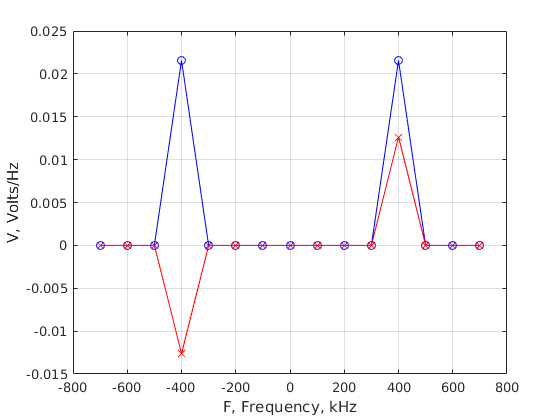
Now let's do a square wave with DC bias
vm=5;phi=0*pi/180;v=double(vm*cos(omega0*t+phi)>0); figure;plot(t,v);grid on; xlabel('t, Time, sec');ylabel('v, Volts'); % Fourier transform V=fftshift(fft(v)/4096*max(t)); test=find(abs(f)<20*f0); figure;plot(f(test),real(V(test)),'b-o',... f(test),imag(V(test)),'r-x');grid on; xlabel('F, Frequency, Hz');ylabel('V, Volts/Hz');
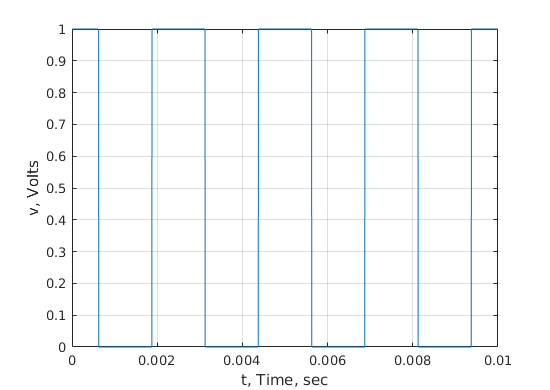
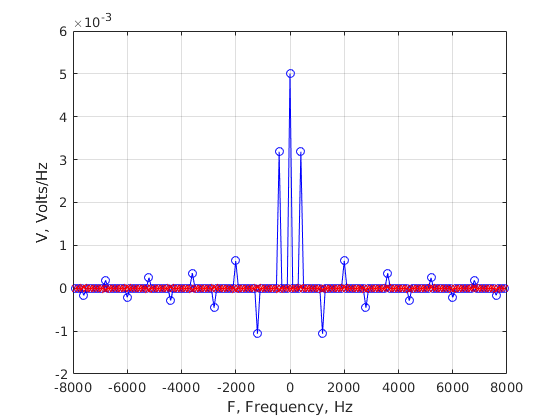
Now a pulse
v=zeros(size(t)); v(1:256)=1; figure;plot(t,v);grid on; xlabel('t, Time, sec');ylabel('v, Volts'); % Fourier transform V=fftshift(fft(v)/4096*max(t)); test=find(abs(f)<20*f0); figure;plot(f(test),real(V(test)),'b-o',... f(test),imag(V(test)),'r-x',... f(test), abs(V(test)),'g-');grid on; xlabel('F, Frequency, Hz');ylabel('V, Volts/Hz');
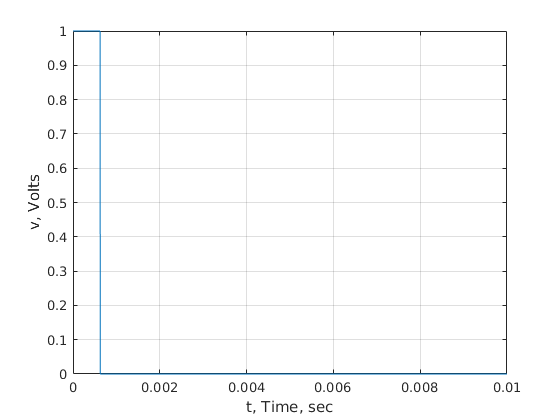
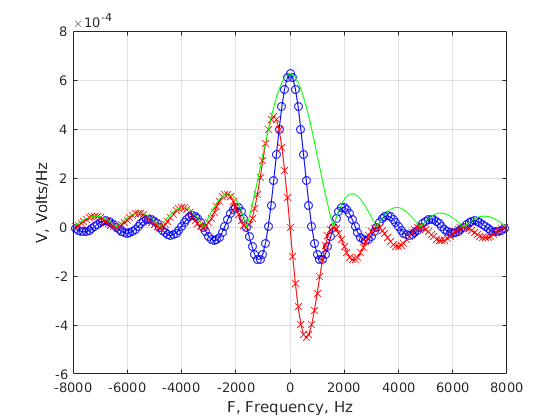
OK. time for an interesting sinusoid
Don't try to understand this until you know about convolution
T1=900.354*10e-3/4096; % Not a power of 2 f1=1/T1 omega1=2*pi*f1; vm1=5;phi1=0*pi/180;v=vm1*cos(omega1*t+phi1); figure;plot(t,v);grid on; xlabel('t, Time, sec');ylabel('v, Volts'); % Fourier transform V=fftshift(fft(v)/4096*max(t)); test=find(abs(f)<5*f0); figure;plot(f(test),real(V(test)),'b-o',... f(test),imag(V(test)),'r-x',... f(test), abs(V(test)),'g-');grid on; xlabel('F, Frequency, Hz');ylabel('V, Volts/Hz');
f1 = 454.9322
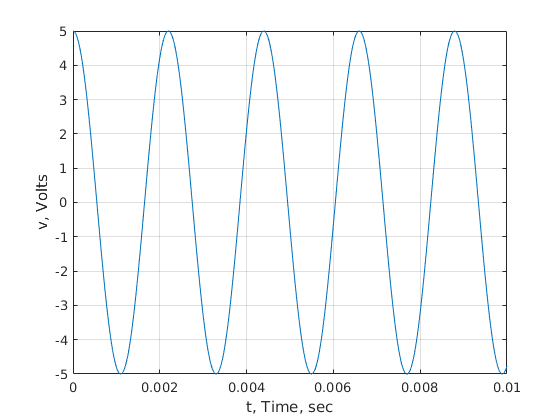
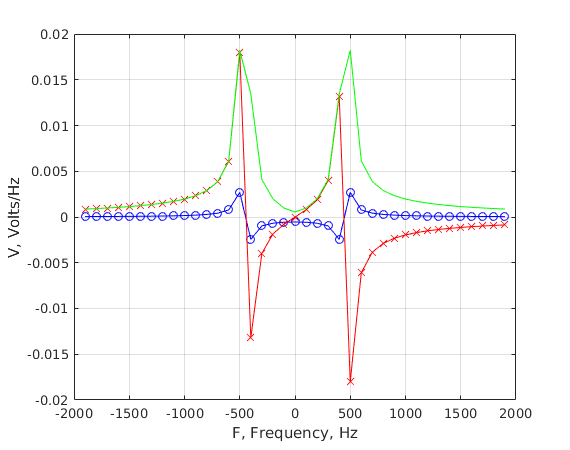
Truncate the sine wave
vt=v; vt(find(t>2.95e-3))=0; figure;plot(t,vt);grid on; xlabel('t, Time, sec');ylabel('v, Volts'); % Fourier transform Vt=fftshift(fft(vt)/4096*max(t)); test=find(abs(f)<5*f0); figure;plot(f(test),real(Vt(test)),'b-o',... f(test),imag(Vt(test)),'r-x',... f(test), abs(Vt(test)),'g-');grid on; xlabel('F, Frequency, Hz');ylabel('V, Volts/Hz'); % Compare the Fourier Transform of a "time window" w=ones(size(t)); w(find(t>2.95e-3))=0; figure;plot(t,w);grid on; xlabel('t, Time, sec');ylabel('Window'); % Fourier transform W=fftshift(fft(w)/4096*max(t)); test=find(abs(f)<5*f0); figure;plot(f(test),real(W(test)),'b-o',... f(test),imag(W(test)),'r-x',... f(test), abs(W(test)),'g-');grid on; xlabel('F, Frequency, Hz');ylabel('FT of Window');
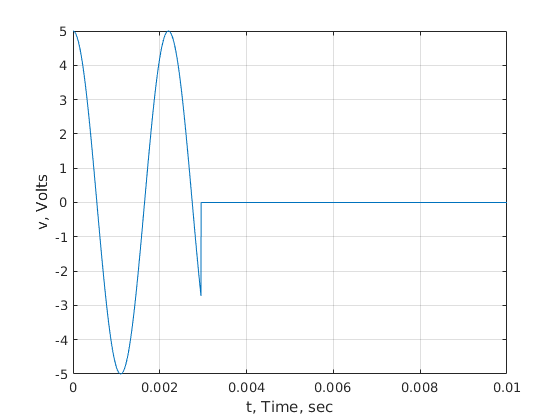
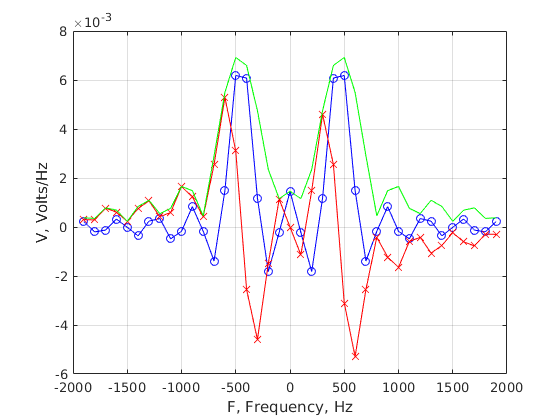
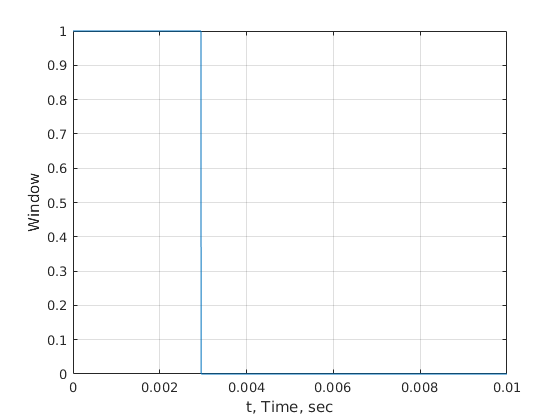
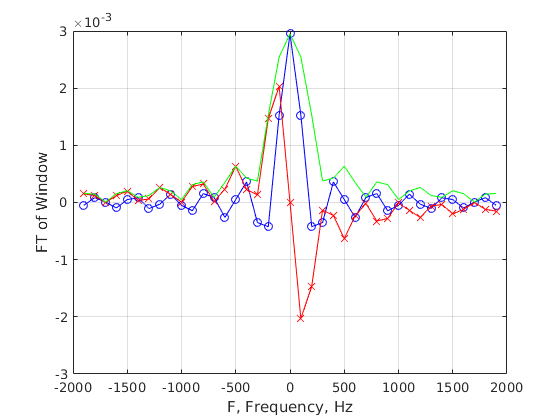
Now. let's add some noise
vn=vt+randn(size(t))*8; figure;plot(t,vn);grid on; xlabel('t, Time, sec');ylabel('v, Volts'); % Fourier transform Vn=fftshift(fft(vn)/4096*max(t)); test=find(abs(f)<5*f0); figure;plot(f(test),real(Vn(test)),'b-o',... f(test),imag(Vn(test)),'r-x',... f(test), abs(Vn(test)),'g-');grid on; xlabel('F, Frequency, Hz');ylabel('V, Volts/Hz'); figure;plot(f(test),20*log10(abs(V(test))),'g-',... f(test),20*log10(abs(Vt(test))),'c-',... f(test),20*log10(abs(Vn(test))),'k-');grid on; xlabel('F, Frequency, Hz');ylabel('V, Volts/Hz'); legend('Full Signal','Truncated','Truncated+Noise'); % Do it in dB over a wider band test=find(abs(f)<50*f0); figure;plot(f(test)/1000,20*log10(abs(V(test))),'g-',... f(test)/1000,20*log10(abs(Vt(test))),'c-',... f(test)/1000,20*log10(abs(Vn(test))),'k-');grid on; xlabel('F, Frequency, kHz');ylabel('V, Volts/Hz'); legend('Full Signal','Truncated','Truncated+Noise');
